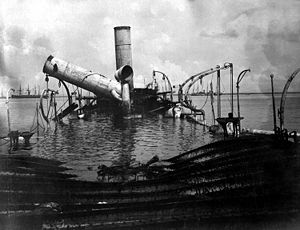Spanish cruiser Reina Cristina

The wreck of Reina Christina after the Battle of Manila Bay in 1898.
|
|
| History | |
|---|---|
|
|
|
| Name: | Reina Cristina |
| Namesake: | Maria Christina of Austria, Queen Consort of Spain |
| Builder: | Ferrol |
| Launched: | 2 May 1887 |
| Fate: | Sunk 1 May 1898 |
| General characteristics | |
| Class and type: | Alfonso XII-class cruiser |
| Displacement: | 3,042 tons |
| Length: | 278 ft 3 in (84.81 m) |
| Beam: | 43 ft 4 in (13.21 m) |
| Draft: | 20 ft 0 in (6.10 m) |
| Installed power: | 4,400 ihp (3,300 kW) |
| Propulsion: | 1-shaft compound |
| Speed: |
|
| Endurance: |
|
| Complement: | 370 officers and enlisted |
| Armament: |
|
Reina Cristina was an Alfonso XII-class unprotected cruiser of the Spanish Navy which fought in the Battle of Manila Bay.
Reina Cristina was built at the naval shipyard at Ferrol and launched 2 May 1887. She had two funnels. Her main armament was built by Hontoria and sponson-mounted. Her five torpedo tubes were all fixed; two were forward, one was on each beam, and one was aft. Although unprotected and therefore lacking armor, she had 12 watertight compartments built in a French-style cellular system to help her resist flooding. She was designed for colonial service, combining high speed with a moderate level of armament; due to chronic boiler problems, however, her designed top speed proved unattainable, and in practice her top speed was about 10 knots (19 km/h; 12 mph). Her design made her unsuited to combat with the types of heavily armed and armored ships she was destined to meet in Manila Bay in 1898.
Reina Cristina spent her early years in Spanish waters. In 1894 she was transferred to the Spanish Navy's Asiatic Squadron to deter any aggressive moves the German Empire might take against the Spanish-owned Caroline Islands in the Pacific. She became flagship of the squadron.
When Spain faced the "Tagalog Revolt" (1896–1897) – the Spanish name for the first two years of the Philippine Revolution – in the Philippine Islands, Reina Cristina was actively involved in the Spanish campaign to put down the revolt. In addition to patrolling Philippine waters to prevent the smuggling of contraband to the insurgents, she also supported Spanish Army actions against them at Cavite, Novaleta, and Binacayan, including the provision of naval gunfire support to Spanish troops ashore.
...
Wikipedia
